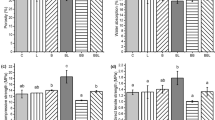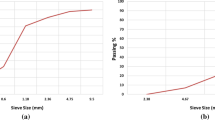Abstract
The use of heat- and alkali-resistant bacteria is essential for the biological repair of damaged concrete. Lysinibacillus boronitolerans YS11 was isolated from the rhizosphere of Miscanthus sacchariflorus. The increased pH in the urea-minus condition during the growth of the YS11 strain promoted calcium carbonate (CaCO3) formation. To identify the optimum medium that promoted the growth of the YS11 strain, a Plackett-Burman design was conducted for the screening process. Consequently, malt powder, rice bran, (NH4)2SO4, and corn syrup were chosen to enhance YS11 growth. The optimization of these four useful factors was carried out using a central composite design. To obtain higher survivability in mortar, the sporulation process is essential, and additional factors such as Mn2+, Fe2+, and Ca2+ were found to contribute to sporulation. A mixture of L. boronitolerans YS11 spore powder, cement, paste, sand, yeast extract, calcium lactate, and water showed a healing effect on a 0.3 mm mortar crack in 7 days. Furthermore, calcium carbonate precipitation was observed over the crack surface. Thus, we confirmed that mortar treated with YS11 spore powder was effective in healing micro-cracks in concrete.
Similar content being viewed by others
References
Bai, Y., Guo, X.J., Li, Y.Z., and Huang, T. 2017. Experimental and vwisual research on the microbial induced carbonate precipitation by Pseudomonas aeruginosa. AMB Express7, 57.
Basha, S., Lingamgusta, L.K., Kannali, J., Gajula, S.K., Bandikari, R., Dasari, S., Dalavai, V., Chinthala, P., Gundala, P.B., Kutagolla, P., et al. 2018. Subsurface endospore-forming bacteria possess biosealant properties. Sci. Rep.8, 6448.
Basu, S., Bose, C., Ojha, N., Das, N., Das, J., Pal, M., and Khurana, S. 2015. Evolution of bacterial and fungal growth media. Bioinformation11, 182–184.
Belie, N.D., Gruyaert, E., Tabbaa, A.A., Antonai, P., Baera, C., Bajare, D., Darquennes, A., Davies, R., Ferrara, L., Jefferson, T., et al. 2018. A review of self-healing concrete for damage management of structures. Adv. Mater. Interfaces5, 17.
Bhosale, S. and Vijayalakshmi, D. 2015. Processing and nutritional composition of rice bran. Curr. Res. Nutr. Food Sci. J.3, 74–80.
Bribián, I.Z., Capilla, A.V., and Usón, A.A. 2011. Life cycle assessment of building materials: Comparative analysis of energy and environmental impacts and evaluation of the eco-efficiency improvement potential. Build Environ.46, 1133–1140.
Carney, L.T. and Lane, T.W. 2014. Parasites in algae mass culture. Front. Microbiol.5, 278.
Christopher, M., Mathew, A.K., Kiran, K.M., Pandey, A., and Sukumaran, R.K. 2017. A biorefinery-based approach for the production of ethanol from enzymatically hydrolysed cotton stalks. Bioresour. Technol.242, 178–183.
Church, B.D. and Harvorson, H. 1959. Dependence of the heat resistance of bacterial endospores on their dipicolinic acid content. Nature183, 124–125.
De Muynck, W., De Belie, N., and Verstraete, W. 2010. Microbial carbonate precipitation in construction materials: A review. Ecol. Eng.36, 118–136.
Driks, A. 2004. From rings to layers: surprising patterns of protein deposition during bacterial spore assembly. J. Bacteriol.186, 4423–4426.
Gat, D., Tsesarsk, Y M., Shamir, D., and Ronen, Z. 2014. Accelerated microbial-induced CaCO3 precipitation in a defined coculture of ureolytic and non-ureolytic bacteria. Biogeosciences11, 2561–2569.
Gill, A. 2017. The importance of bacterial culture to food microbiology in the age of genomics. Front. Microbiol.8, 777.
Granger, A.C., Gaidamakova, E.K., Matrosova, V.Y., Daly, M.J., and Setlow, P. 2010. Effects of Mn and Fe levels on Bacillus subtilis spore resistance and effects of Mn2+, other divalent cations, orthophosphate, and dipicolinic acid on protein resistance to ionizing radiation. Appl. Environ. Microbiol.77, 32–40.
Hager, M.D., Greil, P., Leyens, C., Van Der, Z.S., and Schubert, U.S. 2010. Self-healing materials. Adv. Mater.22, 5323–5430.
Hammes, F. and Verstraete, W. 2002. Key roles of pH and calcium metabolism in microbial carbonate precipitation. Rev. Environ. Sci. Biotechnol.1, 3–7.
Han, S., Choi, E.K., Park, W., and Chung, N. 2019. Effectiveness of expanded clay as a bacteria carrier for self-healing concrete. Appl. Biol. Chem.62, 19.
Huang, J., Ou, Y., Zhang, D., Zhang, G., and Pan, Y. 2018. Optimization of the culture condition of Bacillus mucilaginous using Agaricus bisporus industrial wastewater by Plackett-Burman combined with Box-Behnken response surface method. AMB Express8, 141.
Jacoby, R., Peukert, M., Succurro, A., Koprivova, A., and Kopriva, S. 2017. The role of soil microorganisms in plant mineral nutrition-current knowledge and future directions. Front. Plant Sci.8, 1617.
Jonkers, H.M., Thijssen, A., Muyzer, G., Copuroglu, O., and Schlangen, E. 2010. Application of bacteria as self-healing agent for the development of sustainable concrete. Ecol. Eng.36, 230–235.
Joshi, S., Yadav, S., Nerurkar, A., and Desai, A.J. 2007. Statistical optimization of medium components for the production of biosurfactant by Bacillus licheniformis K51. J. Microbiol. Biotechnol.17, 313–319.
Kim, H.J., Eom, H.J., Park, C., Jung, J., Shin, B., Kim, W., Chung, N., Choi, I.G., and Park, W. 2016. Calcium carbonate precipitation by Bacillus and Sporosarcina strains isolated from concrete and analysis of the bacterial community of concrete. J. Microbiol. Biotechnol.26, 540–548.
Kim, H.J., Shin, B., Lee, Y.S., and Park, W. 2017. Modulation of calcium carbonate precipitation by exopolysaccharide in Bacillus sp. JH7. Appl. Microbiol. Biotechnol.101, 6551–6561.
Koster, S.A.L., Mors, R.M., Nugteren, H.W., Jonkers, H.M., Meesters, G.M.H., and Van Ommen, J.R. 2015. Geopolymer coating of bacteria-containing granules for use in self-healing concrete. Procedia Eng.102, 475–484.
Ku, H., Wang, H., Pattarachaiyakoop, N., and Trada, M. 2011. A review of tensile properties of natural fiber reinforced polymer composites. Compos. Part B-Eng.42, 856–873.
Lagier, J.C., Edouard, S., Pagnier, I., Mediannikov, O., Drancourt, M., and Raoult, D. 2015. Current and past strategies for bacterial culture in clinical microbiology. Clin. Microbiol. Rev.28, 208–236.
Lee, Y.S., Kim, H.J., and Park, W. 2017. Non-ureolytic calcium carbonate precipitation by Lysinibacillus sp. YS11 isolated from the rhizosphere of Miscanthus sacchariflorus. J. Microbiol.55, 440–447.
Lee, Y.S. and Park, W. 2018. Current challenges and future directions for bacterial self-healing concrete. Appl. Microbiol. Biotechnol.102, 3059–3070.
Lee, Y.S. and Park, W. 2019. Enhanced calcium carbonate-biofilm complex formation by alkali-generating Lysinibacillus boronitolerans YS11 and alkaliphilic Bacillus sp. AK13. AMB Express.9, 49.
Leggett, M.J., Mcdonnell, G., Denyer, S.P., Setlow, P., and Maillard, J.Y. 2012. Bacterial spore structures and their protective role in biocide resistance. J. Appl. Microbiol.113, 485–498.
Lucas, S.S., Moxham, C., Tziviloglou, E., and Jonkers, H.M. 2018. Study of self-healing properties in concrete with bacteria encapsulated in expanded clay. Sci. Technol. Mater.30, 93–98.
Meadorparton, J. and Popham, D.L. 2000. Structural analysis of Bacillus subtilis spore peptidoglycan during sporulation. J. Bacteriol.182, 4491–4499.
Mignon, A., Snoeck, D., Dubruel, P., Van, V.S., and De Beli, N. 2017. Crack mitigation in concrete: Superabsorbent polymers as key to success?. Materials10, 237.
Mobley, H.L. and Hausinger, R.P. 1989. Microbial ureases: significance, regulation, and molecular characterization. Microbiol. Rev.53, 85–108.
Mortensen, B.M., Haber, M.J., Dejong, J.T., Caslake, L.F., and Nelson, D.C. 2011. Effects of environmental factors on microbial induced calcium carbonate precipitation. J. Appl. Microbiol.111, 338–349.
Owusu, P.A. and Sarkodie, S.A. 2016. A review of renewable energy sources, sustainability issues and climate changemitigation. Cogent Eng.3, 1167990.
Paritosh, K., Kushwaha, S.K., Yadav, M., Pareek, N., Chawade, A., and Vivekanand, V. 2017. Food waste to energy: an overview of sustainable approaches for food waste management and nutrient recycling. Biomed Res.1, 19.
Palin, D., Wiktor, V., and Honkers, H.M. 2016. A bacteria-based bead for possible self-healing marine concrete applications. Smart Mater. Struct.25, 8.
Park, K.B. and Noguchi, T. 2017. Effects of mixing and curing temperature on the strength development and pore structure of fly ash blended mass concrete. Adv. Mater. Sci. Eng.2017, 1–11.
Popham, D.L., Meadorparton, J., Costello, C.E., and Setlow, P. 1999. Spore peptidoglycan structure in a cwlD dacB double mutant of Bacillus subtilis. J. Bacteriol.181, 6205–6209.
Priya, A., Mandal, A.K., Ball, A.S., Manefield, M., Lal, B., and Sarma, P.M. 2015. Mass culture strategy for bacterial yeast co-culture for degradation of petroleum hydrocarbons in marine environment. Mar. Pollut. Bull.100, 191–199.
Seifan, M., Sarmah, A.K., Samani, A.K., Ebrahiminezhad, A., Ghasemi, Y., and Berenjuan, A. 2018. Mechanical properties of bio self-healing concrete containing immobilized bacteria with iron oxide nanoparticles. Appl. Microbiol. Biotechnol.102, 4489–4498.
Shinohara, Y.M., Sukenobe, J., Imaizumi, T., and Nakahara, T. 2008. Survival of freeze-dried bacteria. J. Gen. Appl. Microbiol.54, 9–24.
Wang, J., Tittelboom, K.V., Belie, N.D., and Verstraete, W. 2012. Use of silica gel or polyurethane immobilized bacteria for self-healing concrete. Constr. Build Mater.26, 532–540.
Wiktor, V. and Jonkers, H.M. 2011. Quantification of crack-healing in novel bacteria-based self-healing concrete. Cemnt. Concrete. Comp.33, 763–770.
Wiktor, V. and Jonkers, H.M. 2016. Bacteria-based concrete: from concept to market. Smart. Mater. Struct.25, 8.
Worrell, E., Price, L., Martin, N., Hendricks, C., and Ozawa, M.L. 2001. Carbon dioxide emissions from the global cement industry. Annu. Rev. Energ. Env.26, 303–329.
Acknowledgments
This work was supported by a grant from the National Institute of Biological Resources (NIBR), funded by the Ministry of Environment (MOE) of the Republic of Korea (NIBR-202002108).
Author information
Authors and Affiliations
Corresponding author
Ethics declarations
Compliance with Ethical Standards This study does not contain any experiment or analysis involving human participants or animals.
Conflict of Interest The authors declare no conflict of interests.
Ethical Statement This study does not contain any experiment or analysis involving human participants or animals.
Electronic supplementary material
Rights and permissions
About this article
Cite this article
Ryu, Y., Lee, KE., Cha, IT. et al. Optimization of bacterial sporulation using economic nutrient for self-healing concrete. J Microbiol. 58, 288–296 (2020). https://doi.org/10.1007/s12275-020-9580-y
Received:
Revised:
Accepted:
Published:
Issue Date:
DOI: https://doi.org/10.1007/s12275-020-9580-y




